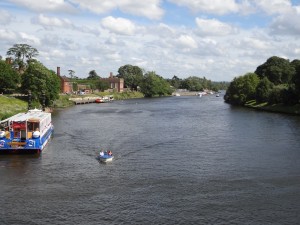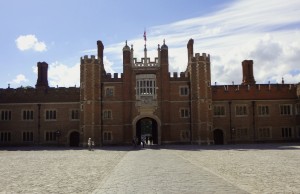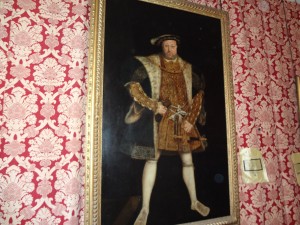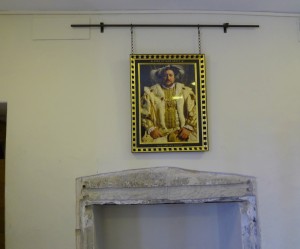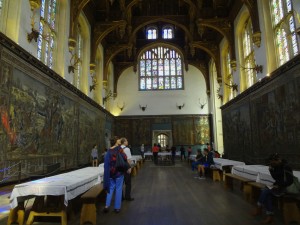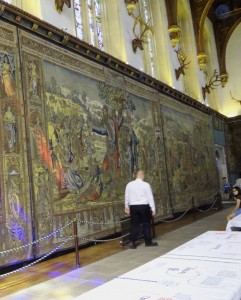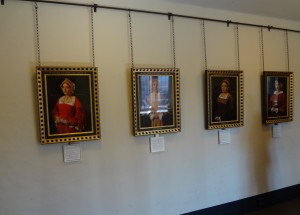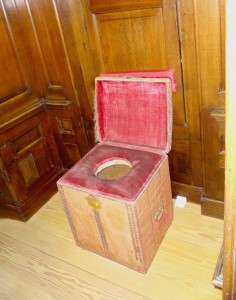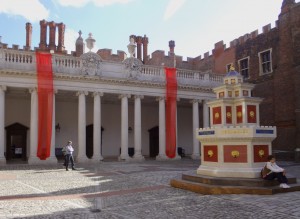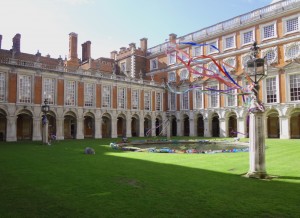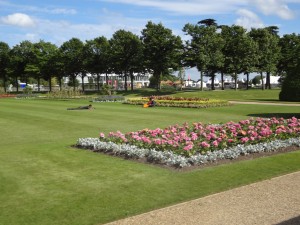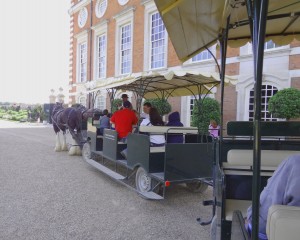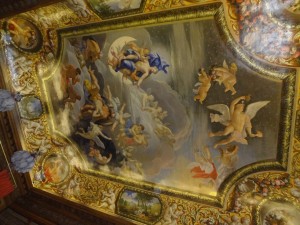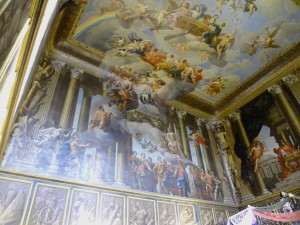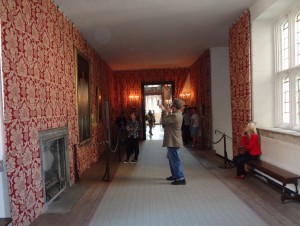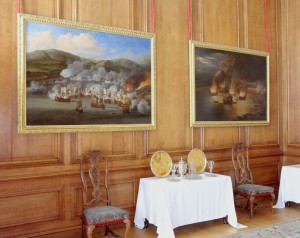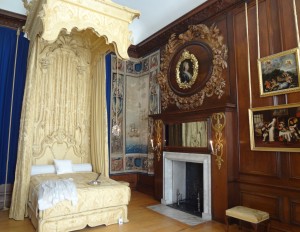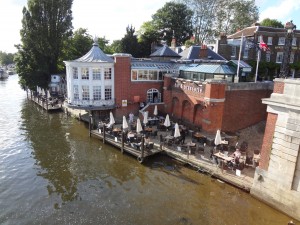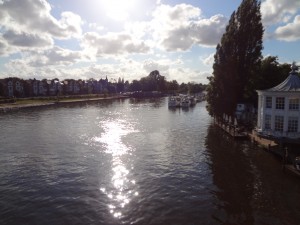About
Hampton Court Palace is the former residence of the English monarchy prior to the 18th century. The palace was originally built and owned by Cardinal Thomas Wolsey and taken by King Henry VIII when Wolsey was unable to convince the Vatican to absolve one of his marriages. The palace has seen many expansions and restorations over the centuries and is a unique combination of Baroque and Tudor styles. The palace was home to Henry VIII, the most famous King in English history.
Location
The palace is almost 12 miles southwest from the center of London in the borough of Richmond. It rests next to the Thames River that flows downstream from the palace through London. It is a 30 minute train ride from central London on the Tube or Underground.
My Experience
After walking all over London I was happy to get a seat on the Underground while I headed towards Richmond where Hampton Court Palace is located. Today Richmond is a borough of London but prior to the 19th century it was located outside of London which was part of its appeal to its royal inhabitants. It was a favorite place to hunt, fish, play tennis, boat on the Thames, walk through the gardens and get away from the masses.
Most of the Tube is underground but some of the trains travel above ground when you reach the outer boroughs. The countryside is pretty around Hampton Court Palace and I was thankful for the short, above ground train ride and pretty scenery as we neared Richmond. From the train station I walked across the Thames on an old bridge and entered into the magnificent royal grounds. My first reaction to Hampton Court Palace was that it was more country home than fortress.
From the distance the palace is imposing. The large property is full of ancient reminders of medieval Kings and Queens of England who lived there for three centuries. Each royal family seemed to make their signature on the palace by modifying it or by adding to it. The entry of the palace was built by Cardinal Thomas Wolsey, one of King Henry VIII’s closest advisors. Upon his fall from grace Henry seized the palace as his own and began enlarging and improving the property.
Much of Henry’s private residence and court remains. The tales of his five wives and the reasons behind the separation the Church of England from the Vatican play a prominent role in the history of the palace. Henry was the first royal owner and the palace is full of his history. He is both a heroic and tragic figure of the English monarchy. Some of the best paintings of the era of Henry VIII have survived and are located at the palace for visitors to peruse.
The Great Hall is the largest room in the palace. Up to 600 people ate here in two sittings, twice a day during Henry’s reign. The magnificent tapestries that line the walls of this large room were commissioned by Henry VIII himself and probably made in France. They were hung for the first time in 1546. The Great Hall also served as the location for dance and drama. Henry himself played a starring role in a specially written chivalric plays, rescuing helpless maidens from dangerous castles.
Henry was not the only King that enjoyed theatre. King James I used the Great Hall for some of the most elaborate theatricals ever staged at an English royal court. Shakespeare appeared on more than one occasion as part of “The King’s Men”, a theatrical troupe that entertained the King. Many times there was dancing and drinking until dawn in the Great Hall before entering into the Great Watching Chamber to eat.
There is a legend that when Henry VIII’s 4th wife, Catherine Howard, found out that she was to be charged with adultery she ran down the processional route hoping to find Henry in the chapel where she would plead her innocence. However Catherine was indeed guilty of infidelity and would be executed in the tower of London. Reportedly her ghost still haunts the gallery.
The chapel is one of the most impressive rooms I have seen in any palace or building in England. Unfortunately, as in most chapels in England, pictures were not allowed to be taken. It has been in use continuously since Thomas Wolsey built it over 500 years ago.
This might be the right place to discuss something I find in most castles, palaces and other old buildings especially where royalty lived. Toilets, called guardrobes in medieval times, were padded stools with a hole in the middle, positioned above a chamber pot. There is a surviving “close stool” on display at the Palace although the one the King used was much more elaborate, padded with black velvet, decorated with swansdown (feathers) and decorated with 2,000 gift nails. Commoners had to use scarce and crowded public stools. Many times a dozen or more people may have been sitting nearby taking care of their business.
Henry VIII was assisted by the gentlemen of his Privy Chamber. It is hard to imagine they were the most senior members of his court. The most important person in the Privy Chamber was the Groom of the Stool, the most important serving position in the palace. He accompanied the King whenever he used the bathroom. This position was highly sought after and probably carried a significant amount of influence with the King. Believe it or not even the King’s bowel movements were of great interest to everyone at the court. Lower members of the court had no privacy as they used the “Great House of Easement” to relieve themselves. The Great House was a 28 seat lavatory for men and boys whose discharge flowed directly into the Thames.
Britain’s first flushing toilet was installed at Hampton Court Palace during Tudor times. Unfortunately it didn’t catch on and Hampton Court continued to be short of facilities. Iron spikes from the 18th century remain in the corners of courtyards intended to discourage courtiers from relieving themselves.
King William III and his wife Queen Mary II (co-monarchs) did more than any other royalty to shape the palace as it is today. Mary was attractive and kind but lacked the confidence to rule. She married William of Orange, a prince from the Netherlands, in an arranged marriage and insisted her co-rule with her. William was shorter than Mary, had a stubborn disposition and was considered “not handsome”. However he proved to be a leader of men in defending his homeland against the French. Anne was Mary’s sister and heir apparent who despised William. Upon Mary’s untimely death to smallpox there was tension among the royals. William was King but he wasn’t British by birth and Anne’s claim to the throne was stronger than his. William ruled until his death in 1702 of pneumonia, 8 years after Mary died and Anne became Queen. William and Mary’s elaborate apartments and living quarters are on full display at the palace today.
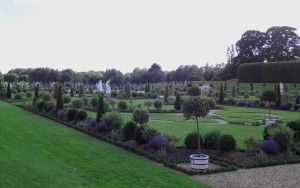
The main garden had little privacy and people sailed up and down the Thames to catch a view of the royals. This garden was built for more privacy.
The palace gardens include great fountains, ponds, banquet facilities, tennis courts and a variety of private gardens; The Rose Garden, The Wilderness and the Maze, the Tiltyard Gardens, 20th Century Garden, the Lower Orangery Garden and the Great Fountain Garden. It was well worth spending $5 to ride in an open carriage pulled by horses around the massive gardens with a tour guide detailing specific history.
The Background and History
Over seven centuries of powerful owners of Hampton Court have changed their palace according to their demands and tastes. Yet no one managed to wipe out their predecessors marks entirely. Hampton Court Palace was valued for its rural setting, hunting and for its unique collection of architectural styles.
Buried beneath the palaces are remains of the first known house built for the Knight Hospitallers of St. John before 1338. It was a large farm estate owned by the holy order’s priory which was originally created to provide funds for crusaders in the Holy Land. In 1494 one of the King’s senior courtiers, Thomas Wolsey leased Hampton Court.
Thomas was a dominant churchman and politician. He acquired the property in 1514. As Henry VIII’s indispensable administrator and Cardinal he gained enormous wealth and power. He turned the house into a palace to entertain the King and receive foreign dignitaries. He built a long gallery overlooking the country and added an entrance court to the existing buildings. He also added several hundred fine tapestries made in France.
By 1525 Hampton Court had become a palace. Wolsey presented it to the King even as he continued to add to the buildings and build a chapel. Hampton Court played an important role in a meeting with French dignitaries in 1527 during negotiation toward a permanent peace the King needed to support his attempts to divorce Queen Katherine of Aragon. Unable to persuade the Pope to annul the marriage was the beginning of the end for Wolsey. In 1529 Henry removed him from the property and took possession.
Henry took personal interest in the palace and began preparing it as a home for his mistress, the future Queen Anne Boleyn. He built personal apartments, a large chamber, kitchens and the Great Hall. He also wanted private lodgings with hot and cold running water which was rare at the time. By the age of 40, with a widening girth, he was no longer able to compete in contests so he built an indoor tennis court and two bowling alleys.
Queen Anne Boleyn never used the new apartments as she fell out of favor and was executed in 1536 on trumped up charges of treason. In 1537 Henry had a new wife and Queen, Jane Seymour. She provided the only male heir to the throne for Henry, Prince Edward. He was baptized in the chapel at Hampton Court. Jane died shortly after childbirth and Henry’s building projects came to an end.
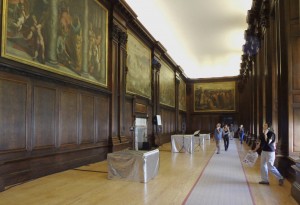
Those are not phones people are talking on but devices used as a Palace guide. This is a large gallery with huge paintings.
Henry married and divorced Anne of Cleves, another brief marriage in 1540. Catherine Howard was the fourth of Henry’s wives. After admitting to being unfaithful to Henry she was executed in the Tower of London (she asked for the chopping block the night before the execution so she could get comfortable putting her head on it). Henry took a fifth wife, Catherine Parr, who managed to outlive him by a year. In 1547, his son Prince Edward became King at 9 years old. Edward was under care of his uncle, the Duke of Somerset. The Duke took over the Queen’s apartments at Hampton Court when the court stayed at the palace in the summer. Edward died six years later at age 15. Before his death he took steps to keep England from returning to Catholicism by naming Lady Jane Grey as the next Queen over his two half-sisters, Mary and Elizabeth. Mary would become Queen after raising an army and earn the nickname “Bloody Mary” for her heavy-handed attempt to restore England to Catholicism.
Mary accepted King Philip of Spain’s offer to marry. In one of the more unusual royal stories Mary was confined to the palace during, what was later determined, a false pregnancy. All of Europe awaited the birth of a baby as Mary gained weight and displayed other symptoms of being pregnancy. The birth was never to occur and she was humiliated. She became fatally ill and died 3 years later.
King James I spent his first Christmas as King in Hampton Court Palace. William Shakespeare, one of “The King’s Men” entertained him by performing plays. Hampton Court also served as a location for religious debates on the King James translation of the Bible.
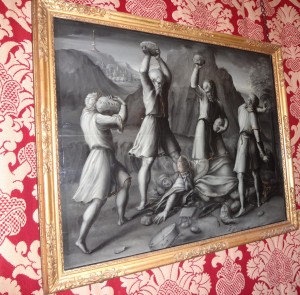
Shows the writers of the four gospels stoning the Pope. This was a painting from the era of King Henry VIII.
King Charles I was a great art collector and bought works from the great Italian masters to decorate the palace. Charles was executed at the end of the civil war, between Royalists and Parliamentarians, and most of the royal valuables were sold off to the benefit of the Commonwealth. Oliver Cromwell, hero of the Parliamentary Forces, as named Lord Protector of England and used the Palace for his own pleasure where he lived like a king.
In 1660, the monarchy was restored and the pleasure loving Charles II added a tennis court to his favorite palace and hunting lodge. Charles II’s brother, James II, used the palace sparingly. His Roman Catholic beliefs led him to make big changes in the palace. James was ousted to France in the “Glorious Rebellion”. His daughter Mary II married William of Orange and co-reigned. They put a lot of money and resources into restoring Hampton Court on a grand scale. Christopher Wren, famed Baroque architect, was hired to modify the palace to rival the palaces of Louis XIV in France.
Mary oversaw the restoration while William was away fighting wars. Mary suddenly died of smallpox. The distraught king completed the project 6 years later. He died shortly after its completion from a fall suffered on his horse in the garden.
The next two monarchs, Queen Anne and King George I, were unenthusiastic about the court although Anne did complete the modernization of the chapel. George II and Queen Caroline filled the palace with their family. Hampton Court was already in decline by this time as a royal palace. When George died his grandson, George III, became King. He reportedly had bad memories of Hampton Court from his childhood. He began the system of granting unused apartments to members of the royal court. No British monarch would live at Hampton Court Palace again.
Hampton Court became an unlikely village of well-to-do ladies, mostly widows. Charles Dickens called them “Gypsies of Gentility” in his book titled Little Dorritt. In 1839 Queen Victoria opened Hampton Court to large numbers of paying visitors. During the Victorian era Hampton Court was restored and became valuable as an important place in English history. The palace has become a popular tourist attraction that is able to maintain its beauty without any government assistance, surviving on private donations and fees paid by visitors. In 1986, portions of the King’s apartments were damaged in a fire. Several years later, the apartments reopened completely restored.
Ratings (Estate and Royal Houses)
Category Rating: A-
Overall Rating: #4
Comments: This is definitely an all day trip. There is a significant amount of British history on display of the monarchs who ruled England between King Henry VIII and Queen Victoria. Palaces are always worth visiting.
